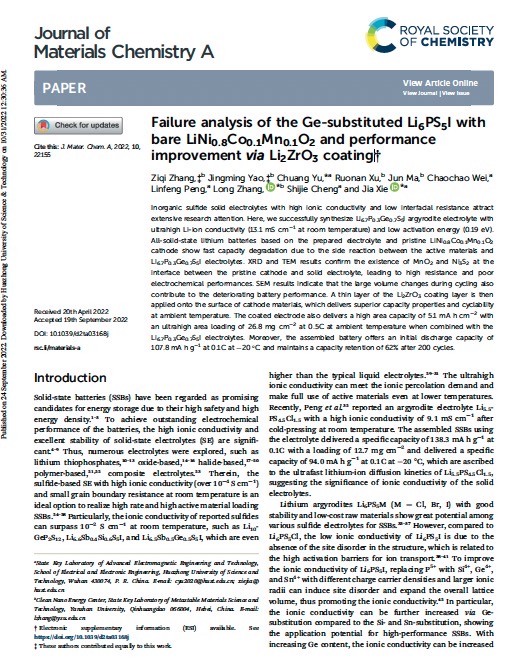
Indexed by: Journal paper
Journal: Journal of Materials Chemistry A
Included Journals: SCI
Affiliation of Author(s): 华中科技大学电气与电子工程学院
Place of Publication: 英国
Discipline: Engineering
First-Level Discipline: Material Science and Engineering
Document Type: J
Volume: 10
Issue: 41
Page Number: 22155-22165
Key Words: lithium argyrodite, Ge-substituted, conductivity, solid-state batteries, wide operating temperature ranges
DOI number: 10.1039/d2ta03168j
Date of Publication: 2022-10-25
Impact Factor: 14.511
Teaching and Research Group: 电力系
Abstract: Inorganic sulfide solid electrolytes with high ionic conductivity and low interfacial resistance attract extensive research attention. Here, we successfully synthesize Li6.7P0.3Ge0.7S5I argyrodite electrolyte with ultrahigh Li-ion conductivity (13.1 mS/cm at room temperature) and low activation energy (0.19 eV). All-solid-state lithium batteries based on the prepared electrolyte and pristine LiNi0.8Co0.1Mn0.1O2 cathode show fast capacity degradation due to the side reaction between the active materials and Li6.7P0.3Ge0.7S5I electrolytes. XRD and TEM results confirm the existence of the MnO2 and Ni3S2 at the interface between the pristine cathode and solid electrolyte, leading to high resistance and poor electrochemical performances. SEM results indicate that the large volume changes during cycling also contribute to the deteriorating battery performance. A thin layer of Li2ZrO3 coating layer is then applied onto the surface of cathode materials, which delivers superior capacity properties and cyclability at ambient temperature. The coated electrode also delivers a high area capacity of 5.1 mAh/cm2 with an ultrahigh area loading of 26.8 mg/cm2 at 0.5C under ambient temperature when combined with the Li6.7P0.3Ge0.7S5I electrolytes. Moreover, the assembled battery offers an initial discharge capacity of 107.8 mAh/g at 0.1 C under -20 oC and maintains capacity retention of 62% after 200 cycles.

